List of heads of state of Argentina
You can help expand this article with text translated from the corresponding article in Spanish. (April 2012) Click [show] for important translation instructions.
|
| President of the Argentine Nation | |
|---|---|
| Presidente de la Nación Argentina | |
 Presidential Standard | |
since 10 December 2015 | |
| Style | Excelentísimo Señor (m) Excelentísima Señora (f) |
| Residence | Casa Rosada (government office) Quinta de Olivos (official residence) Chapadmalal Residence (summer house) |
| Term length | Four years, renewable once |
| Inaugural holder | Bernardino Rivadavia |
| Formation | first: 1826 Constitution current: 1853 Constitution, (amended in 1994). |
| Salary | 77,855.65 Argentine pesos[1] (as of February 2016) |
| Website | Office of the President |
 |
|---|
|
|
Argentina has had many different types of heads of state, as well as many different types of government throughout its history. During Pre-Columbian times the territories that today form Argentina were inhabited by nomadic tribes, without any defined government. During the Spanish colonization of the Americas, the King of Spain retained the ultimate authority over the territories conquered in the New World, appointing viceroys for local government. The territories that would later become Argentina were first part of the Viceroyalty of Peru, and then the Viceroyalty of the Río de la Plata. The May Revolution started the Argentine War of Independence by replacing the viceroy Baltasar Hidalgo de Cisneros with the first national government. It was the Primera Junta, a junta of several members, which would grow into the Junta Grande with the incorporation of provincial deputies. The size of the Juntas gave room to internal political disputes among their members, so they were replaced by the First and Second Triumvirate, of three members. The Assembly of the Year XIII created a new executive authority, with attributions similar to that of a head of state, called the Supreme Director of the United Provinces of the Río de la Plata. A second Assembly, the Congress of Tucumán, declared independence in 1816 and promulgated the Argentine Constitution of 1819. However, this constitution was repealed during armed conflicts between the central government and the Federal League Provinces. This started a period known as the Anarchy of the Year XX, when Argentina lacked any type of head of state.
There was a new attempt to organize a central government in 1826. A new congress wrote a new constitution, and elected Bernardino Rivadavia as president in the process.[2] Thus Rivadavia was the first president of Argentina. However, he resigned shortly after, and the 1826 constitution was repealed. The Argentine provinces then organized themselves as a confederation, without a central head of state. In this organization, the governors of Buenos Aires province took some duties such as the payment of external debt or the administration of the foreign relations in the name of all provinces.[3] Those governors were appointed by the Buenos Aires legislature, with the only exception of Juan Lavalle. Juan Manuel de Rosas kept the governor office for seventeen consecutive years, until Justo José de Urquiza defeated him at the 1852 Battle of Caseros. Urquiza then called for a new Constitutional Assembly, and promulgated the Argentine Constitution of 1853, which is the current Constitution of Argentina through amendments. In 1854, Urquiza became the first President of modern Argentina, acting both as head of government and head of state.[4] However, the Buenos Aires Province had rejected the Constitution and became an independent state until the aftermath of the 1859 Battle of Cepeda, although the internecine conflict continued. Only after the subsequent Battle of Pavón, in 1861, the former bonaerense leader Bartolomé Mitre became the first president of an unified Argentine Republic.[5]
The succession line of constitutional presidents run uninterrupted until 1930, when José Félix Uriburu took government through a civic-military coup d'état. For many decades, there was an alternance between legitimate Presidents and others that took government through illegitimate means. Those means included coups d'état, but also proscriptions of major political parties[6] and electoral fraud.[6][7] The last coup d'état occurred in 1976, and resulted in the National Reorganization Process, which ended in 1983. The retrospective recognition as presidents or heads of state of any de facto ruler that exercised its authority outside the Constitutional mandate is a controversial and relevant issue in Argentine politics.[8][9][10] However, their government actions were recognized as valid following the de facto government doctrine that used to legitimize them.[11] This doctrine was rejected by the 1994 amendment, and wouldn't be applicable for potential future coups. The current head of state is President Mauricio Macri, who took office on 10 December 2015.
United Provinces of the Rio de la Plata (1810–1831)
Junta presidents (1810–1811)
| Portrait | Name (Birth–Death) |
Term of office | Notes | Refs |
|---|---|---|---|---|

|
Cornelio Saavedra (1759–1829) |
President of the Primera Junta, at the beginning of the Argentine War of Independence. He is regarded as the first president of a national government.[12] | [13] | |
| President of the Junta Grande. Left to serve in the Army of the North. | ||||
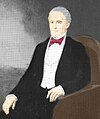
|
Domingo Matheu (1765–1831) |
President of the Junta Grande, from Saavedra's departure to the dissolution of it. | [14] |
Triumvirates (1811–1814)
| Members (Births–Deaths) Tenure | |||
|---|---|---|---|
| First Triumvirate | |||

|
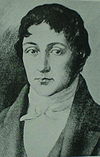
|

|

|
| Feliciano Chiclana (1761–1826) |
Manuel de Sarratea (1774–1849) |
Juan José Paso (1758–1833) |
Juan Martín de Pueyrredón (1776–1850) |
| 23 September 1811 – 8 October 1812 | 23 September 1811 – 8 October 1812 | 23 September 1811 – 23 March 1812 | 23 March 1812 – 8 October 1812 |
| — | Resigned | Replaced Paso | |
| Second Triumvirate | |||

|

|

|
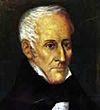
|
| Juan José Paso (1758–1833) |
Nicolás Rodríguez Peña (1775–1853) |
Antonio Álvarez Jonte (1784–1820) |
Gervasio Antonio de Posadas (1757–1833) |
| 8 October 1812 – 31 January 1814 | 8 October 1812 – 31 January 1814 | 8 October 1812 – 19 August 1813 | 19 August 1813 – 31 January 1814 |
| — | Resigned | Replaced Álvarez Jonte | |
Supreme directors (1814–1820)
| Portrait | Name (Birth–Death) |
Term of office | Notes | Refs |
|---|---|---|---|---|

|
Gervasio Antonio de Posadas (1757–1833) |
Chosen by the Assembly of the Year 1813. | [15] | |

|
Carlos María de Alvear (1789–1852) |
Forced to resign by a mutiny | [16] | |
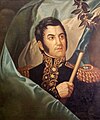  
|
José de San Martín (1778-1850) Matías de Irigoyen (1781-1839) Manuel de Sarratea (1774–1849) |
Third Triumvirate. Interim government until the appointment of a new Supreme Director. | ||

|
José Rondeau (1773–1844) |
Appointed successor of Alvear, could not take office because he was in command of the Army of the North | [17] | |

|
Ignacio Álvarez Thomas (1787–1857) |
Acting, for Rondeau. Convened the Congress of Tucumán, that would declare Independence. | [18] | |
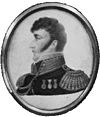
|
Antonio González de Balcarce (1774–1819) |
Interim | [19] | |

|
Juan Martín de Pueyrredón (1776–1850) |
First Argentine Head of State after the Argentine Declaration of Independence. Supported the Crossing of the Andes. | [20] | |

|
José Rondeau (1773–1844) |
Decisively defeated at the Battle of Cepeda by Federalist forces opposed to the 1819 centralist Constitution. | [21] | |

|
Juan Pedro Aguirre (1781–1837) |
Interim. Dissolved the National Congress and endorsed the Buenos Aires Cabildo to choose a Governor for Buenos Aires Province. |
Governors of Buenos Aires Province managing international relations (1820–1826)
Between 1820 and 1826, the United Provinces functioned as a loose alliance of autonomous provinces put together by pacts and treaties (v.g. Treaty of Pilar, Treaty of Benegas, Quadrilateral Treaty) but lacking any actual central government until the 1825 Constitutional Congress.
| Portrait | Name (Birth–Death) |
Term of office | Notes | Refs |
|---|---|---|---|---|

|
Matías de Irigoyen (1781–1839) |
Interim until the appointment of Manuel de Sarratea. | ||
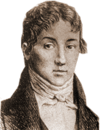
|
Manuel de Sarratea (1774–1849) |
The political crisis that existed in the country led to his government lacked support from both Buenos Aires and the other provinces. Thus he resigned shortly afterwards. | ||

|
Juan Ramón González Balcarce (1773–1836) |
Interim. Resigned. | ||

|
Manuel de Sarratea (1774–1849) |
He returned to office after the end of the brief government of Balcarce. The circumstances did not improve and ended up resigning a second time. | ||

|
Ildefonso Ramos Mexía (1769–1854) |
Designado como gobernador propietario en todo el lleno de facultades en lo político, económico y militar por el espacio de ocho meses nombró un consejo formado por notables,[22] aunque fue destituido poco después por la crisis imperante. | ||

|
Ildefonso Ramos Mexía and Miguel Estanislao Soler | They took power simultaneously. | ||

|
Miguel Estanislao Soler (1783–1849) |
He assumed de facto, after an armed uprising, but his government lasted a few days, when the Board of Representatives appointed Manuel Dorrego. | ||
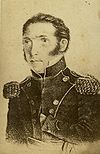
|
Manuel Dorrego (1787–1828) |
Interim. | ||

|
Martín Rodríguez (1771–1845) |
He signed the Treaty of Benegas and the Quadrilateral | ||
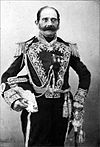
|
Juan Gregorio de Las Heras (1780–1866) |
He called a Constituent Congress that enacted several laws for which the Unitary Republic was proclaimed. He resigned because of that republic. |
First presidential government (1826–1827)
| № | Portrait | Name (Birth–Death) |
Term of office — Political party |
Notes |
Refs | |
|---|---|---|---|---|---|---|
| 1 | 
|
Bernardino Rivadavia (1780–1845) |
8 February 1826 | 7 July 1827 | Elected by the Constituent Assembly of 1826, before the promulgation of the 1826 constitution.[2] Waged the Cisplatine War. Resigned as the Constitution was rejected by the provinces and the outcome of the war generated popular discontent. | [2]: 23–32 |
| Unitarian | ||||||
| 2 | 
|
Vicente López y Planes (1785–1856) |
7 July 1827 | 18 August 1827 | Elected as interim president by the Constituent Assembly of 1826. His mandate was limited to close the Assembly and call for elections for a new governor of Buenos Aires. | [2] |
Governors of Buenos Aires Province managing international relations (1827–1831)
| Portrait | Name (Birth–Death) |
Term of office — Political party |
Notes |
Refs | ||
|---|---|---|---|---|---|---|
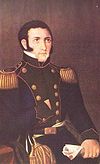
|
Manuel Dorrego (1787–1828) |
18 August 1827 | 13 December 1828 | Ended the Cisplatine War. Deposed and executed by Juan Lavalle. | [23] | |
| Federal | ||||||

|
Juan Lavalle (1797–1841) |
13 December 1828 | 26 June 1829 | Coup d'état. Defeated in battle, resigned under siege | [24] | |
| Unitarian | ||||||

|
Juan José Viamonte (1774–1843) |
26 June 1829 | 6 December 1829 | Interim. | [25] | |
| Federal | ||||||
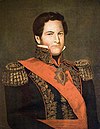
|
Juan Manuel de Rosas (1793–1877) |
6 December 1829 | 4 January 1831 | First term. Convened the Federal Pact and waged war against the Unitarian League. Resigned. | [26] | |
| Federal | ||||||
Argentine Confederation (1831–1861)
Governors managing international relations (1831–1852)
| Portrait | Name (Birth–Death) |
Term of office — Political party |
Notes |
Refs | ||
|---|---|---|---|---|---|---|

|
Juan Manuel de Rosas (1793–1877) |
4 January 1831 | 17 December 1832 | Governor of Buenos Aires Province. First term. Convened the Federal Pact and waged war against the Unitarian League. Resigned. | [27] | |
| Federal | ||||||

|
Juan Ramón Balcarce (1773–1836) |
17 December 1832 | 4 November 1833 | Governor of Buenos Aires Province. Ousted by the Revolution of the Restorers. | [28] | |
| Federal | ||||||

|
Juan José Viamonte (1774–1843) |
4 November 1833 | 27 June 1834 | Governor of Buenos Aires Province. Interim. | [29] | |
| Federal | ||||||

|
Manuel Vicente Maza (1779–1839) |
27 June 1834 | 7 March 1835 | Governor of Buenos Aires Province. Interim. | [30] | |
| Federal | ||||||

|
Juan Manuel de Rosas (1793–1877) |
7 March 1835 | 3 February 1852 | Governor of Buenos Aires Province with the sum of public power. Waged the Argentine and Uruguayan Civil Wars, the War of the Confederation and the French and Anglo-French blockade of the Río de la Plata. Designated "Supreme Chief of the Argentine Confederation" in 1851. Defeated by Justo José de Urquiza at the Battle of Caseros. Resigned. | [31] | |
| Federal | ||||||

|
Vicente López y Planes (1785–1856) |
3 February 1852 | 6 April 1852 | Governor of Buenos Aires Province. Iterim. Governor of Buenos Aires Province without national powers until 26 July 1852. | ||
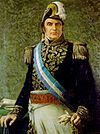
|
Justo José de Urquiza (1801–1870) |
6 April 1852 | 31 May 1852 | Governor of Entre Ríos Province. | ||
| Federal | ||||||
Presidents (1852–1861)
| № | Portrait | Name (Birth–Death) |
Term of office — Political party |
Elections | Notes |
Refs | |
|---|---|---|---|---|---|---|---|
| 3 | 
|
Justo José de Urquiza (1801–1870) |
31 May 1852 | 5 March 1854 | - | Provisional Director of the Argentine Confederation. Governor of Buenos Aires Province between 26 July 1852 and 4 September 1852. | [32] |
| 5 March 1854 | 5 March 1860 | 1854 | Elected by the electoral college. President of the Argentine Confederation. The reincoporation of the State of Buenos Aires was negotiated after the 1859 Battle of Cepeda. First constitutional President of Argentina. | ||||
| Federal | |||||||
| 4 | 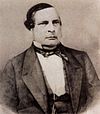
|
Santiago Derqui (1809–1867) |
5 March 1860 | 4 November 1861 | 1860 | Indirect elections. On October 18, 1860, a Constitutional reform is adopted, proclaiming the Argentine Republic. Resigned after the national government lost the Battle of Pavón to Buenos Aires. | [33] |
| Federal | |||||||
| 5 | 
|
Juan Esteban Pedernera (1796–1886) |
4 November 1861 | 12 December 1861 | - | Vice-president under Derqui, assumed the presidency after his resignation. Resigned on the dissolution of the national government. | [33] |
Argentine Republic (1861–present)
Presidents (1861–present)
| № | Portrait | Name (Birth–Death) |
Term of office — Political party |
Elections | Notes |
Refs | |
|---|---|---|---|---|---|---|---|
| 6 | 
|
Bartolomé Mitre (1821–1906) |
12 December 1861 | 12 October 1862 | - | Governor of State of Buenos Aires. Acting President of Argentina after the Battle of Pavón. Confirmed as Interim President by the National Congress in May 1862. | [34] |
| 12 October 1862 | 12 October 1868 | 1862 | Indirect elections. First president of the unified country. Waged the War of the Triple Alliance. | ||||
| Liberal Party (PL) | |||||||
| 7 | 
|
Domingo Faustino Sarmiento (1811–1888) |
12 October 1868 | 12 October 1874 | 1868 | Indirect elections. Ended the War of the Triple Alliance. | [34] |
| Liberal Party (PL) | |||||||
| 8 | 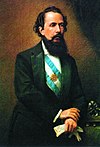
|
Nicolás Avellaneda (1837–1885) |
12 October 1874 | 12 October 1880 | 1874 | Indirect elections. Federalization of Buenos Aires City in September 1880. | [34] |
| National Party (PN) | |||||||
| 9 | 
|
Julio Argentino Roca (1843–1914) |
12 October 1880 | 12 October 1886 | 1880 | Indirect elections. First term. | [35] |
| National Autonomist Party (PAN) | |||||||
| 10 | 
|
Miguel Juárez Celman (1844–1909) |
12 October 1886 | 6 August 1890 | 1886 | Indirect elections. Resigned following the Revolution of the Park. | [36] |
| PAN – PN | |||||||
| 11 | 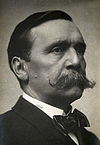
|
Carlos Pellegrini (1846–1906) |
6 August 1890 | 12 October 1892 | - | Vice-president under Juárez Celman, assumed the presidency after his resignation. | [36] |
| PAN | |||||||
| 12 | File:Sin título8.jpg | Luis Sáenz Peña (1822–1907) |
12 October 1892 | 22 January 1895 | 1892 | Indirect elections. Resigned. | [37] |
| PAN | |||||||
| 13 | 
|
José Evaristo Uriburu (1831–1914) |
22 January 1895 | 12 October 1898 | - | Vice-president under Sáenz Peña, assumed the presidency after his resignation. | [37] |
| PAN | |||||||
| (9) | 
|
Julio Argentino Roca (1843–1914) |
12 October 1898 | 12 October 1904 | 1898 | Indirect elections. Second term. | [38] |
| PAN | |||||||
| 14 | 
|
Manuel Quintana (1835–1906) |
12 October 1904 | 12 March 1906 | 1904 | Indirect elections. Died in office. | [39] |
| PAN | |||||||
| 15 | 
|
José Figueroa Alcorta (1860–1931) |
25 January 1906 | 12 March 1906 | - | Vice-president under Quintana. Acting president during his illness. | |
| PAN | |||||||
| 12 March 1906 | 12 October 1910 | - | Vice-president under Quintana, assumed the presidency after his death. | [39] | |||
| PAN | |||||||
| 16 | 
|
Roque Sáenz Peña (1851–1914) |
12 October 1910 | 9 August 1914 | 1910 | Indirect elections. Promoted the Sáenz Peña law, which allowed secret, universal and mandatory suffrage. Died in office. | [40] |
| PAN – Modernist | |||||||
| 17 | 
|
Victorino de la Plaza (1840–1919) |
9 August 1914 | 12 October 1916 | - | Vice-president under Sáenz Peña, assumed the presidency after his death. | [40] |
| PAN | |||||||
| (18) | 
|
Hipólito Yrigoyen (1852–1933) |
12 October 1916 | 12 October 1922 | 1916 | Free indirect elections. First president elected under the Sáenz Peña law. First term. Maintained neutrality during World War I. | [41] |
| Radical Civic Union (UCR) | |||||||
| 19 | 
|
Marcelo Torcuato de Alvear (1868–1942) |
12 October 1922 | 12 October 1928 | 1922 | Free indirect elections. | [41] |
| UCR | |||||||
| (18) | 
|
Hipólito Yrigoyen (1852–1933) |
12 October 1928 | 6 September 1930 | 1928 | Free indirect elections. Second term, ousted from office by a civico-military coup. | [42] |
| UCR | |||||||
| 20 | 
|
José Félix Uriburu (1868–1932) |
6 September 1930 | 20 February 1932 | - | First coup d'etat in modern Argentine history. Beginning of the Infamous Decade. | [43] |
| Military | |||||||
| 21 | 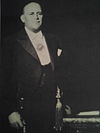
|
Agustín Pedro Justo (1876–1943) |
20 February 1932 | 20 February 1938 | 1931 | Indirect elections held with fraud, the UCR was proscribed.[6] | [44] |
| Concordancia | |||||||
| 22 | 
|
Roberto María Ortiz (1886–1942) |
20 February 1938 | 27 June 1942 | 1937 | Indirect elections held with fraud.[7] Resigned for health reasons, died one month later. | [7]: 136–155 |
| UCRA – Concordancia | |||||||
| 23 | 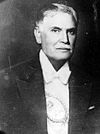
|
Ramón Castillo (1873–1944) |
27 June 1942 | 4 June 1943 | - | Vice-president under Ortiz, assumed the presidency after his resignation. Deposed in a coup d'état. End of the Infamous Decade. | [7] |
| PDN – Concordancia | |||||||
| 24 | 
|
Arturo Rawson (1885–1952) |
4 June 1943 | 7 June 1943 | - | Coup d'état. Beginning of the Revolution of '43. Ousted from office.[45] | [7] |
| Military | |||||||
| 25 | 
|
Pedro Pablo Ramírez (1884–1962) |
7 June 1943 | 9 March 1944 | - | Coup d'état. On 25 February 1944, Ramírez temporarily delegated powers to Edelmiro Farrell. Resigned. | [7] |
| Military | |||||||
| 26 | 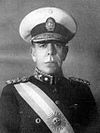
|
Edelmiro Julián Farrell (1887–1980) |
25 February 1944 | 9 March 1944 | - | Acting president. | |
| Military | |||||||
| 9 March 1944 | 4 June 1946 | - | Coup d'état. Declared war to the Axis powers. Called elections. End of the Revolution of '43. | [7] | |||
| Military | |||||||
| 27 | 
|
Juan Domingo Perón (1895–1974) |
4 June 1946 | 4 June 1952 | 1946 | Free indirect elections. First term. Reelection enabled by the Constitution of 1949. | [46] |
| Laborista (Labour) Party | |||||||
| 4 June 1952 | 20 September 1955 | 1951 | Free direct elections. Second term. First election to allow women's suffrage. Victory with 62.49% of votes, highest victory in Argentine elections. Ousted from office by a military coup. | ||||
| Justicialist Party (PJ) | |||||||
| - | - | 20 September 1955 | 23 November 1955 | - | During fighting between loyalist forces and rebels there was no clear president. | ||
| 28 | 
|
Eduardo Lonardi (1896–1956) |
23 September 1955 | 13 November 1955 | - | Coup d'etat. Beginning of the Revolución Libertadora. Ousted from office. | [47] |
| Military | |||||||
| 29 | 
|
Pedro Eugenio Aramburu (1903–1970) |
13 November 1955 | 1 May 1958 | - | Coup d'état. The 1949 Constitution is repealed and the 1853 Constitution is restored. Call for elections with Peronism proscribed. End of the Revolución Libertadora. | [47] |
| Military | |||||||
| 30 | 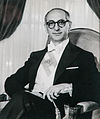
|
Arturo Frondizi (1908–1995) |
1 May 1958 | 29 March 1962 | 1958 | Indirect elections with Peronism proscribed. Ousted from office by a military coup. | [48] |
| UCRI | |||||||
| 31 | José María Guido (1910–1975) |
29 March 1962 | 12 October 1963 | - | Provisional President of the Senate, acting as president since the removal of Frondizi, as the civil procedures to replace the deposed president were followed and Vice President Alejandro Gómez had resigned in 1958.[49] | [48] | |
| UCRI | |||||||
| 32 | 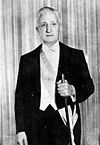
|
Arturo Umberto Illia (1900–1983) |
12 October 1963 | 28 June 1966 | 1963 | Indirect elections with Peronism proscribed. Ousted from office by a military coup. | [50] |
| UCRP | |||||||
| - | Military Junta | 28 June 1966 | 29 June 1966 | - | |||
| Military | |||||||
| 33 | 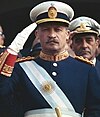
|
Juan Carlos Onganía (1914–1995) |
29 June 1966 | 8 June 1970 | - | Coup d'état. First ruler of the Revolución Argentina. Ousted from office. | [50] |
| Military | |||||||
| - | Military Junta | 8 June 1970 | 18 June 1970 | - | |||
| Military | |||||||
| 34 | 
|
Roberto M. Levingston (1920–2015) |
18 June 1970 | 23 May 1971 | - | Coup d'état. Ousted from office. | [50] |
| Military | |||||||
| 35 | 
|
Alejandro A. Lanusse (1918–1996) |
26 May 1971 | 25 May 1973 | - | Coup d'état. Last ruler of the Revolución Argentina. Called for elections. Peronism proscription lifted. | |
| Military | |||||||
| 36 | 
|
Héctor José Cámpora (1909–1980) |
25 May 1973 | 13 July 1973 | 1973 | Free direct elections. First Peronist president after the proscription. Cámpora annulled the proscription that remained specifically over Juan Perón, and resigned. The Vice President, Vicente Solano Lima, resigned with him. | [51] |
| PJ – FJL | |||||||
| 37 | 
|
Raúl Alberto Lastiri (1915–1978) |
13 July 1973 | 12 October 1973 | - | Interim. President of the Chamber of Deputies, assumed the presidency after Cámpora's and Solano Lima's resignations. Alejandro Díaz Bialet, President of the Senate and ahead of Lastiri in the succession line, was on a diplomatic mission in Africa at that time.[52] | [51] |
| PJ | |||||||
| (27) | 
|
Juan Domingo Perón (1895–1974) |
12 October 1973 | 1 July 1974 | 1973 | Free direct elections. Third term. Died in office. | [51] |
| PJ | |||||||
| 38 | 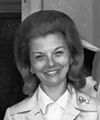
|
Isabel Martínez de Perón (1931–) |
1 July 1974 | 24 March 1976 | - | Vice-president of Juan Perón, assumed the presidency after his death. First female president in the Americas. Ousted from office by a military coup. | [53] |
| PJ | |||||||
| - | Military Junta | 24 March 1976 | 29 March 1981 | - | |||
| Military | |||||||
| 39 | 
|
Jorge Rafael Videla (1925–2013) |
29 March 1976 | 29 March 1981 | - | Coup d'état. President of the Military Junta. First ruler of the National Reorganization Process. Longest government of a de facto ruler. | [54] |
| Military | |||||||
| 40 | 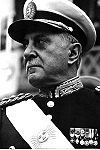
|
Roberto Eduardo Viola (1924–1994) |
29 March 1981 | 11 December 1981 | - | Appointed by Videla as President of the Military Junta. Powers and duties suspended on 21 November 1981 due to health problems. Ousted from office. | [54] |
| Military | |||||||
| - | Horacio Tomás Liendo (1924–2007) |
21 November 1981 | 11 December 1981 | - | Acting president during Viola suspension. | ||
| Military | |||||||
| - | 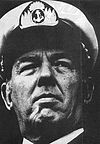
|
Carlos Alberto Lacoste (1929–2004) |
11 December 1981 | 22 December 1981 | - | Interim president. | |
| Military | |||||||
| 41 | 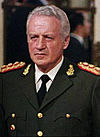
|
Leopoldo Galtieri (1926–2003) |
22 December 1981 | 18 June 1982 | - | Coup d'état. President of the Military Junta. Waged the Falklands War (Template:Lang-es). Ousted from office. | [54] |
| Military | |||||||
| - | 
|
Alfredo Oscar Saint-Jean (1926–1987) |
18 June 1982 | 1 July 1982 | - | Interim president. | |
| Military | |||||||
| 42 | 
|
Reynaldo Bignone (1928–) |
1 July 1982 | 10 December 1983 | - | Coup d'état. Last ruler of the National Reorganization Process. Called for elections. | [54] |
| Military | |||||||
| 43 | 
|
Raúl Alfonsín (1927–2009) |
10 December 1983 | 8 July 1989 | 1983 | Free indirect elections. The 1989 presidential elections were anticipated. Alfonsín resigned during the transition and gave power to Carlos Menem six months in advance. | [55] |
| UCR | |||||||
| 44 | 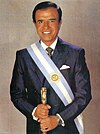
|
Carlos Menem (1930–) |
8 July 1989 | 8 July 1995 | 1989 | Free indirect elections. First term. The 1994 amendment of the Argentine Constitution reduced the presidential term to four years and allowed a single consecutive reelection. | [56] |
| 8 July 1995 | 10 December 1999 | 1995 | Free direct elections. Second term. | ||||
| PJ | |||||||
| 45 | 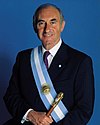
|
Fernando de la Rúa (1937–) |
10 December 1999 | 20 December 2001 | 1999 | Free direct elections. Faced a severe economic crisis. Resigned after the December 2001 riots. Because his Vice-president Carlos Álvarez had resigned in October 2000 the Congress Assembled selected a new President. |
[57] |
| UCR – Alianza | |||||||
| - | 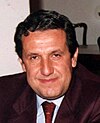
|
Ramón Puerta (1951–) |
20 December 2001 | 22 December 2001 | - | Provisional President of the Senate exercised the Executive Power interim. | |
| PJ | |||||||
| 46 | 
|
Adolfo Rodríguez Saá (1947–) |
22 December 2001 | 30 December 2001 | - | Elected by the Congress Assembled for three months, with instructions to call for elections. Resigned. | [58] |
| PJ | |||||||
| - | 
|
Eduardo Camaño (1946–) |
30 December 2001 | 2 January 2002 | - | President of the Chamber of Deputies was in charge interim. | |
| PJ | |||||||
| 47 | 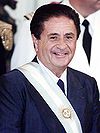
|
Eduardo Duhalde (1941–) |
2 January 2002 | 25 May 2003 | - | Elected by the Congress Assembled, with instructions to complete De la Rúa's term. Called early elections for 27 April 2003. | [58] |
| PJ | |||||||
| 48 | 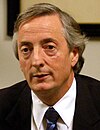
|
Néstor Kirchner (1950–2010) |
25 May 2003 | 10 December 2007 | 2003 | Free direct elections. The law that allowed Duhalde to resign gave the new president both the four-year mandate and the remaining months of De la Rúa's term. Kirchner lost the first round to Carlos Menem, but the latter forfeited the second round that should have followed. | [59] |
| PJ – FPV | |||||||
| 49 | 
|
Cristina Fernández de Kirchner (1953–) |
10 December 2007 | 10 December 2011 | 2007 | Free direct elections. First term. First female president of Argentina elected as head of the list. | [60] |
| 10 December 2011 | 10 December 2015[61] | 2011 | Free direct elections. Second term. By judicial ruling, her mandate ended 10 December 2015 at 0:00 hs. Provisional President of the Senate Federico Pinedo was in charge interim for 12 hours. | ||||
| PJ – FPV | |||||||
| 50 | 
|
Mauricio Macri (1959–) |
10 December 2015 | Incumbent | 2015 | Free direct elections. First president elected in a ballotage, defeating Daniel Scioli. | |
| PRO – Cambiemos | |||||||
Timeline of Head of States of Argentina by affiliation
Affiliation Keys
| Colour key | ||
|---|---|---|
|
Unitarian (19th Century Centralists)
Federal (19th Century Federalists)
Liberal - (19th Century Liberals)
National Autonomist Party (1874–1916)
Radicals - UCR (founded 1891), UCR-A (1924–1946), UCRI (1956–1972), UCRP (1957–1972), Alianza (UCR, FREPASO) (1997–2001)
Peronists - Laborista (Labour) Party (1945–1947), PJ (founded 1947), FJL (1972–1974), FPV (since 2003)
Military (Acting on behalf of the Armed Forces)
| ||
| Party abbreviations | ||
| Alianza | Alianza por el Trabajo, la Justicia y la Educación | Alliance for Work, Justice and Education (1997–2001) (UCR, FREPASO) |
| Aut | Partido Autonomista | Autonomist Party (1862–1874) |
| Camb | Cambiemos | Let's Change (since 2015) (PRO, UCR, CC-ARI) |
| Conc | Concordancia | Concordance (1931–1943) (UCR-A, PSI, PDN) |
| Fed | Federal | 19th Century Federals |
| FJL | Frente Justicialista de Liberación Nacional (FREJULI) | Justicialist Front for National Liberation (1972–1974) |
| FPV | Frente para la Victoria | Front for Victory (since 2003) |
| Lab | Partido Laborista | Labour Party (1945–1947) |
| Lib | Liberal | 19th Century Liberals |
| Mil | Military | Acting on behalf of the Armed Forces |
| Mod | Partido Autonomista Nacional (línea modernista) | National Autonomist Party -Modernist (1892–1916) |
| PAN | Partido Autonomista Nacional | National Autonomist Party (1874–1916) |
| PDN | Partido Demócrata Nacional | National Democratic Party (1931–1955) |
| PJ | Partido Justicialista | Justicialist Party (founded 1947) |
| PRO | Propuesta Republicana | Republican Proposal (founded 2005) |
| UCR | Unión Cívica Radical | Radical Civic Union (founded 1891) |
| UCR-A | UCR Antipersonalista | Anti-Yrigoyenist UCR (1924–1946) |
| UCRI | Unión Cívica Radical Intransigente | Radical Civic Union -Intransigent (1956–1972) |
| UCRP | Unión Cívica Radical del Pueblo | Radical Civic Union of the People (1957–1972) |
| Unitarian | Unitario | 19th Century Centralists |
See also
- President of Argentina
- Politics of Argentina
- List of Vice-Presidents of Argentina
- Lists of incumbents
Bibliography
- Mendelevich, Pablo (2010). El Final (in Spanish). Buenos Aires: Ediciones B. ISBN 978-987-627-166-0.
- Rosa, José María (1974). Historia Argentina (in Spanish). Buenos Aires: Editorial Oriente S.A.
- Abal Medina (h.), Juan; Suárez Cao, Julieta (August 2003). "Análisis crítico del sistema electoral argentino. Evolución histórica y desempeño efectivo". Revista de Ciencias Sociales (in Spanish). 14. Bernal: National University of Quilmes.
References
- ^ Iván Ruiz and Maia Jastreblansky (February 11, 2016). "El primer sueldo de Mauricio Macri como Presidente: $131.421 brutos" (in Spanish). La Nación. Retrieved February 11, 2016.
{{cite web}}: Unknown parameter|trans_title=ignored (|trans-title=suggested) (help) - ^ a b c d Mendelevich, p. 28
- ^ Mendelevich, p. 33
- ^ Mendelevich, p. 24
- ^ Mendelevich, p. 46
- ^ a b c Mendelevich, p. 130—131
- ^ a b c d e f g Mendelevich, p. 136
- ^ Braslavsky, Guido (25 September 2008). "Alfonsín vuelve a la Casa Rosada para inaugurar su propia estatua" (in Spanish). Clarín (newspaper). Retrieved November 7, 2010.
{{cite web}}: Cite has empty unknown parameter:|coauthors=(help); Unknown parameter|trans_title=ignored (|trans-title=suggested) (help) - ^ "Quieren quitar los nombres de militares de las calles" (in Spanish). El Argentino. 21 November 2008. Retrieved November 7, 2010.
{{cite web}}: Unknown parameter|trans_title=ignored (|trans-title=suggested) (help) - ^ Ginzberg, Victoria (19 January 2003). "Los protocolos y las decisiones políticas" (in Spanish). Página/12. Retrieved November 7, 2010.
{{cite web}}: Unknown parameter|trans_title=ignored (|trans-title=suggested) (help) - ^ Groisman, Enrique. "Los gobiernos de facto en el derecho argentino" (PDF) (in Spanish). Centro de estudios políticos y constitucionales. Retrieved November 7, 2010.
{{cite web}}: Unknown parameter|trans_title=ignored (|trans-title=suggested) (help) - ^ "Buenos Aires, diciembre 16 de 1829.- El primer comandante de Patricios, el primer presidente de un gobierno patrio, pudo sólo quedar olvidado en su fallecimiento por las circunstancias calamitosas en que el país se hallaba. Después que ellas han terminado, sería una ingratitud negar a ciudadano tan eminente el tributo de honor rendido a su mérito, y a una vida ilustrada con tantas virtudes, que supo consagrar entera al servicio de su patria. El gobierno, para cumplir un deber tan sagrado, acuerda y decreta: Artículo 1º: En el cementerio del Norte se levantará, por cuenta del gobierno, un monumento en que se depositarán los restos del brigadier general D. Cornelio Saavedra. Artículo 2º: Se archivará en la Biblioteca Pública un manuscrito autógrafo del mismo brigadier general, con arreglo a lo que previene el decreto de 6 de octubre de 1821. Artículo 3º: Comuníquese y publíquese. Rosas – Tomás Guido".
- ^ Rosa, vol. II, p.199-306
- ^ Rosa, vol. II, p. 306-319
- ^ Rosa, Vol. III, p. 75-114
- ^ Rosa, vol. III, p. 114-129
- ^ Rosa, vol. III, p. 143
- ^ Rosa, vol. III, p. 143-160
- ^ Rosa, vol. III, p. 160
- ^ Rosa, vol. III, p. 161-242
- ^ Rosa, vol. III, p. 242-253
- ^ http://www.antiqbook.com/boox/atn/W01A000329.shtml
{{citation}}: Missing or empty|title=(help); Unknown parameter|título=ignored (|title=suggested) (help) - ^ Rosa, vol. V, p.73-97
- ^ Rosa, vol. IV, p.97-117
- ^ Rosa, vol. IV, p 127-129
- ^ Rosa, vol. IV, p. 129-171
- ^ Rosa, vol. IV, p. 129-171
- ^ Rosa. vol. IV, p. 186-196
- ^ Rosa, vol. IV, p. 198-204
- ^ Rosa, vol. IV, p. 206-213
- ^ Rosa, vol. IV p. 219 - vol. V p. 489
- ^ Mendelevich, p. 38-41
- ^ a b Mendelevich, p. 42-45
- ^ a b c Mendelevich, p.46-52
- ^ Mendelevich, p. 53-56
- ^ a b Mendelevich, p. 57-65
- ^ a b Mendelevich, p. 66-72
- ^ Mendelevich, p. 73-79
- ^ a b Mendelevich, p. 80-88
- ^ a b Mendelevich, p. 89-101
- ^ a b Mendelevich, p. 102-112
- ^ Mendelevich, p. 113-125
- ^ Mendelevich, p. 126-129
- ^ Mendelevich, p. 130-135
- ^ Mendelevich, p. 145
- ^ Mendelevich, p. 156-176
- ^ a b Mendelevich, p. 177-186
- ^ a b Mendelevich, p. 187-195
- ^ Mendelevich, p. 193
- ^ a b c Mendelevich, p. 196-214
- ^ a b c Mendelevich, p. 215-228
- ^ Mendelevich, p. 223
- ^ Mendelevich, p. 229-235
- ^ a b c d Mendelevich, p. 236-241
- ^ Mendelevich, p. 242-245
- ^ Mendelevich, p. 247-252
- ^ Mendelevich, p. 253-262
- ^ a b Mendelevich, p. 263-277
- ^ Mendelevich, p. 278-282
- ^ Mendelevich, p. 283-292
- ^ http://www.cronista.com/economiapolitica/Texto-completo-del-fallo-de-Servini-de-Cubria-sobre-el-fin-de-mandato-de-Cristina-Kirchner-20151209-0106.html
External links
- Rulers.org — Argentina list of rulers for Argentina



